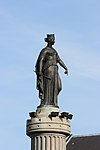| Revision as of 08:39, 13 March 2014 editTaksen (talk | contribs)Extended confirmed users, Pending changes reviewers31,513 edits pic← Previous edit | Revision as of 05:04, 17 March 2014 edit undoTaksen (talk | contribs)Extended confirmed users, Pending changes reviewers31,513 edits →The siege: refNext edit → | ||
| Line 26: | Line 26: | ||
| The siege of September 1792 was one of the many battles fought during the ] and considered a major event in the city's history by its inhabitants, despite its relatively low military significance on a wider scale. | The siege of September 1792 was one of the many battles fought during the ] and considered a major event in the city's history by its inhabitants, despite its relatively low military significance on a wider scale. | ||
| A few months earlier, in April 1792, French forces in the same area did not conduct themselves well - fleeing after a skirmish with Austrian forces and afterwards killing their own commander, ]. This might have made the Austrians expect an easy victory, which as it turned out was not the case. | A few months earlier, in April 1792, French forces in the same area did not conduct themselves well - fleeing after a skirmish with Austrian forces and afterwards killing their own commander, ]. This might have made the Austrians expect an easy victory, which as it turned out was not the case.<ref>Rickard, J (8 January 2009), Battle of Baisieux, 29 April 1792 , </ref> | ||
| An Austrian army besieged the city of ]. For nine days and nights, the Austrians bombarded the city without intermission, but had ultimately to raise the siege, faced with the determined resistance of the citizens, led by Mayor ]. They Austrians did destroy many houses and the main church (Saint-Etienne) of the city, which was on the ''Grand′ Place'' (today the ''Place du Général de Gaulle''). | An Austrian army besieged the city of ]. For nine days and nights, the Austrians bombarded the city without intermission, but had ultimately to raise the siege, faced with the determined resistance of the citizens, led by Mayor ]. They Austrians did destroy many houses and the main church (Saint-Etienne) of the city, which was on the ''Grand′ Place'' (today the ''Place du Général de Gaulle''). | ||
Revision as of 05:04, 17 March 2014
| This article does not cite any sources. Please help improve this article by adding citations to reliable sources. Unsourced material may be challenged and removed. Find sources: "Column of the Goddess" – news · newspapers · books · scholar · JSTOR (October 2007) (Learn how and when to remove this message) |
The Column of the Goddess is the popular name given by the citizens of Lille (France) to the Memorial of the Siege of 1792. The memorial is still in the center of the Grand′ Place (central square) of Lille, and has been surrounded by a fountain since around 1990.
| Siege of Lille | |||||||
|---|---|---|---|---|---|---|---|
| Part of the French Revolutionary War | |||||||
 The Austrian bombardement of Lille in October 1792. The city was attacked by Albert Casimir, Duke of Teschen. Painting by Louis Joseph Watteau on The Siege of Lille | |||||||
| |||||||
| Belligerents | |||||||
|
|
| ||||||
The siege
The siege of September 1792 was one of the many battles fought during the French Revolutionary Wars and considered a major event in the city's history by its inhabitants, despite its relatively low military significance on a wider scale.
A few months earlier, in April 1792, French forces in the same area did not conduct themselves well - fleeing after a skirmish with Austrian forces and afterwards killing their own commander, Théobald Dillon. This might have made the Austrians expect an easy victory, which as it turned out was not the case.
An Austrian army besieged the city of Lille. For nine days and nights, the Austrians bombarded the city without intermission, but had ultimately to raise the siege, faced with the determined resistance of the citizens, led by Mayor François André. They Austrians did destroy many houses and the main church (Saint-Etienne) of the city, which was on the Grand′ Place (today the Place du Général de Gaulle).
The monument


The church was never to be re-built and the Grand' Place of Lille is still one of the few local central places without either a church or a belfry (unlike similar cities such as Bruges and Brussels).
Hyacinthe Jadin composed his Marche du siège de Lille in 1792, in the direct aftermath of the siege. For many years there was, however, no physical monument in the city itself. Some fifty years later, the local authorities became aware that nothing had been made to commemorate the 50th birthday of this event. They decided on the building of a memorial, just in time to lay the first stone in September 1842, but it was not before 1845 that the memorial was finished.
The memorial consists of a column topped by a statue. The column was designed by the architect Charles Benvignat, while the statue was sculpted by Théophile Bra as an allegory of the besieged city wearing a mural crown. It was nicknamed the Goddess by the inhabitants of Lille soon after the erection of the memorial, as some local poems suggest.
50°38′13″N 3°3′48″E / 50.63694°N 3.06333°E / 50.63694; 3.06333
Categories: